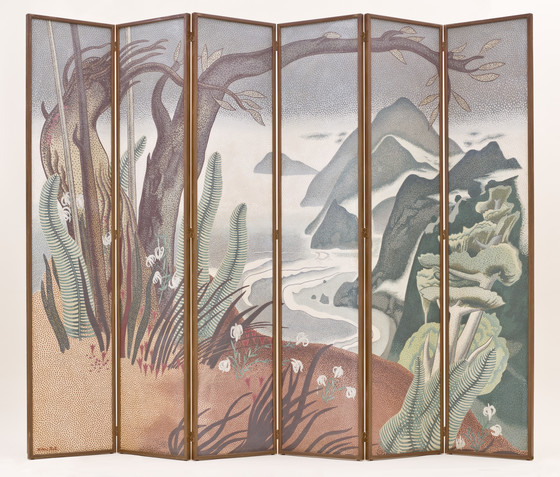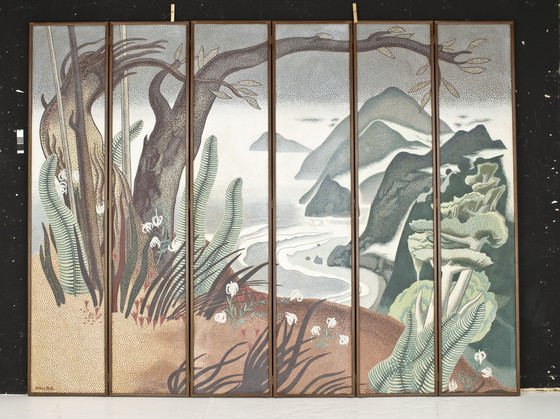Millard Sheets holds several major positions in the history of American and California art....
Millard Sheets holds several major positions in the history of American and California art. He was not only one of the leading American Scene painters of the 1930s, but later became one of the foremost teachers in the country as well as a significant organizer of exhibitions. He was also an important practitioner in the field of design.
Today, Sheet's contribution to the decorative arts is most often identified with his "Home Savings and Loan" buildings. Beginning in 1954 and through his association with financier Howard Ahmanson, his most enthusiastic supporter, Sheets designed the buildings and decorations — mainly mosaic and painted murals, stained glass windows, and sculptures — for 40 bank branches throughout southern California. Many of these were actually studio creations; Sheets taught and then hired his students to assist in the design and creation of the modern mosaic murals, thereby encouraging the following generation of designers, artisans, and painters. However, Sheets' involvement in design began much earlier. While still a student at Chouinard School of Art in the late 1920s, he began painting murals and doing architectural designs for private clients. According to his son, Tony Sheets, Millard "became committed early on to the concept of art in architecture — the idea of architects and artists working together f or a combined outcome — as opposed to art on architecture, where the architect places art on his already completed building as an afterthought." Less well documented and definitely little known and seen are his private commissions for painted murals that decorate the dining and living rooms of private homes (some of which Sheets designed himself) throughout the area. The murals were often lyrical landscapes of the rolling hills and terrain of California, and demonstrate another genre in which the artist excelled — landscape painting.
Some time in either the late 1920s or early 1930s, Sheets also experimented with the folding screen format. Painted screens became quite popular during the interwar years in the United States and even Regionalists as famous as Thomas Hart Benton explored the genre. It is not known exactly why Sheets began painting screens or whether he was aware of the Russian and German Bauhaus belief that modern art could improve the life of everyday people through thoughtful design. He no doubt was familiar with the Arts and Crafts movement so strong in Southern California. Whatever his source and initial inspiration, the folding screen enabled Sheets to combine in a single work of art his two main interests — painting and the decorative arts. Later he would collect Japanese and Chinese screens.
It is not known how many of folding screens Sheets actually completed, but only two are presently known and located. In both examples, Sheets presented more of a generic, idealized landscape rather than a specific scene of California, although in this example the imagery does suggest aspects of the state's rugged coastlline. Across the six panels, the shore view of rocks and sea is seen from high up, with wind-bent, leafless trees framing the view and directing the eye toward the distance, as large ferns and other plants blow in the wind. Swirling lines of the water near the beach and the bold outlines of rocks and plants create an incessant feeling of movement. The colors are strong but limited in number. The screen shares formal qualities that are the hallmark of Sheets' 1930s easel paintings: bold design, rich coloration, and unusual perspectives. Such bold stylized forms would reappear in Sheets' art much later, especially characterizing his postwar landscapes, and provide them a decorative feeling.
The museum has a significant collection of Sheets' work, including his most famous painting, Angel's Flight, 1930 (one of the American Art Department's top ten paintings) and a related drawing for it, prints as well as examples of his war work, and popular late watercolors.
More...

